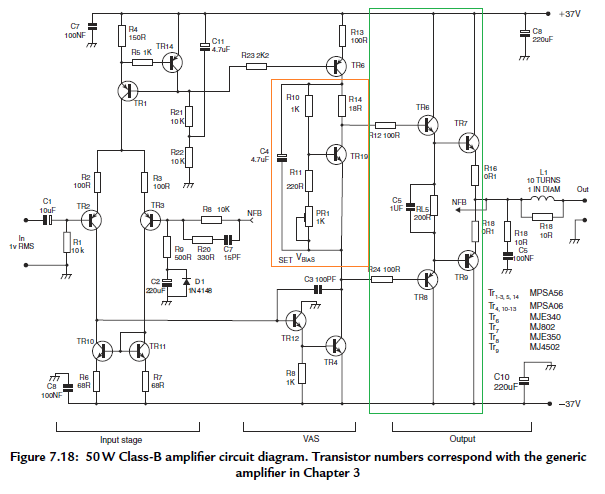It also uses a \$V_{BE}\$ multiplier instead of a pair of diodes (in the orange box I added.) But again, the idea is the same. Just in this case you can tweak the voltage. Also, this \$V_{BE}\$ multiplier includes a resistor in the collector, \$R_{14}\$, that compensates the \$V_{BE}\$ multiplier for the Early Effect in \$TR_{19}\$. Again, this is just an adjustment to the basic idea but needed to slightly improve its performance in the circuit.
Note that this amplifier system uses two supply rails, plus ground. Namely, \$\pm 37\:\textrm{V}\$. From the equation I mentioned above, you can work out that this means \$P=\frac{V_P^2}{2\cdot R}=\frac{\left(37\:\textrm{V}\right)^2}{2\cdot 8\:\Omega}\approx 85\:\textrm{W}\$. However, if you count diode drops from the output back to either rail and roughly consider the necessary collector-emitter voltages required by a few BJTs there, you can easily see a need for about \$6\:\textrm{V}\$ of overhead on each side of ground. So this brings it back to about \$60\:\textrm{W}\$. Other considerations bring it down further, to the stated \$50\:\textrm{W}\$ rating mentioned by the author.
The use of two rails means that an output capacitor can be avoided, directly driving one end of a grounded speaker. An added reason why dual supply rails (or else a bridge-tied load) might be worth considering.
The circuit also includes negative feedback (look for the NFB terminal mark on the schematic in two places.) This helps by using some of the open loop gain to help linearize the output and to deal with issues such as cross-over distortion that may be present.
Real circuits are like that. You start with a basic idea that does work somewhat and then you add more to it in order to deal with various unwanted behaviors, correcting those that are more important and ignoring those that you can accept or tolerate.

